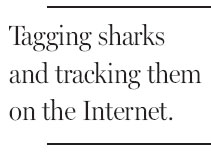Program seeks to uncover shark secrets
Updated: 2012-10-21 08:01
By Katharine Q. Seelye(The New York Times)
|
|||||||
|
The crew of the Ocearch tagged Genie, a great white shark, with a GPS device in September, hoping to learn her breeding and travel patterns. Gretchen Ertl for The New York Times |
CHATHAM, Massachusetts - Beachgoers on Cape Cod may have spotted several sharks this summer, but when Chris Fischer and his crew - former subjects of the television show "Shark Wranglers" - went looking for the great whites here in early September, there were none.
Crew members scanned the sea from their converted crabbing vessel, the Ocearch, anchored approximately five kilometers off the Cape. They tossed out chum and waited.
Nine days passed. Then, on September 13, a giant shark that would become known as Genie burst into oceanographic history. Hooked in the corner of her mouth, she was, Mr. Fischer said, the first great white - all
1,040 kilograms of her - to be captured live off Cape Cod, the home waters of the movie "Jaws."
The Ocearch crew held her for 15 minutes in a cradle off the side of the boat. Scientists attached a Global Positioning System tag to her dorsal fin and took blood and tissue samples before releasing her. Now the researchers, and anyone with an Internet connection, can follow her movements in real time online on the "shark tracker" on ocearch.org.
Four days later, the team landed a much bigger female - Mary Lee, who weighed in at 1,568 kilograms and measured about five meters. She exhausted herself before the crew pulled her into the cradle, with her thrashing tail swatting three of them.
Catching sharks is something that Mr. Fischer, the founding chairman of Ocearch, a nonprofit organization that facilitates research on oceans and fish, and his crew have done scores of times. Before arriving here, they completed a similar expedition off South Africa, where they tagged dozens of great whites whose travel patterns can also be followed online.
The purpose of their mission, said Mr. Fischer, 44, is to understand the sharks' migratory patterns and breeding habits, with the goal of providing policy makers with data to protect them.

Some environmentalists see the live capture of sharks as more invasive than other methods of tagging, like using a harpoon to implant a tracking device. Environmentalists argue that the use of hooks and a method that exhausts the sharks before pulling them out of the water subjects them to unnecessary trauma. During the South African expedition, one shark died.
There was concern that in addition to harming the sharks, the Ocearch project was being carried out under the guise of science for sensationalist and for-profit purposes like reality television. Mr. Fischer and his crew completed their 16-day expedition on September 20 with periodic visits from scientists and journalists but no reality-TV cameras.
Mr. Fischer dismissed the objections. He said tags implanted on sharks through harpooning are less reliable than those attached to the fin because they can fall off after six months and they emit a signal only if receivers are placed in the water around them. It is impossible, he said, to plant receivers everywhere the sharks might go. By contrast, the GPS tags can be read by satellites every time the fin breaks the surface of the water and can emit signals for five years.
Greg Skomal, a shark expert working for Massachusetts, was on the Cape Cod expedition. He has tagged sharks through harpooning, but this was the first time he had his hands on a live one. "Any time you capture a fish by any methodology, you're going to expose it to some level of stress," he said. "But we try to minimize that."
Through an instrument called an accelerometer - similar to a "black box" in an airplane that was attached to the sharks for several hours - Dr. Skomal could follow their behavior after they were released.
Genie and Mary Lee are now broadcasting their locations to satellites and creating an online trail of where they have traveled since they were tagged.
From Chatham, Genie headed south, and then turned around; she is now lurking off the southern coast of Nantucket, Massachusetts. Mary Lee swam north to Wellfleet, Massachusetts, veered out into the Atlantic and then headed south.
"They show up at the Cape and they leave, and we don't know anything about them or what they're doing," Mr. Fischer said. "This tracking will begin to reveal their lives. Anybody can learn about these sharks and follow their story."
Online: Tracking the Sharks
Video and photos of researchers tagging a great white shark: nytimes.com
Search "Ocearch"
The New York Times
(China Daily 10/21/2012 page11)
